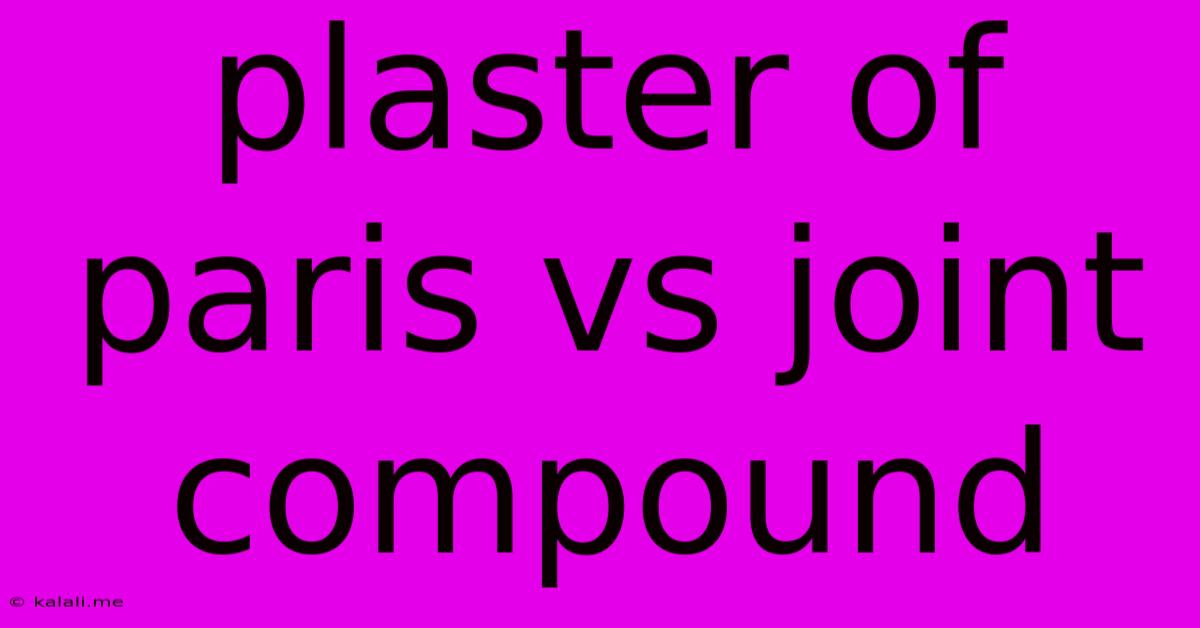Plaster Of Paris Vs Joint Compound
Kalali
May 23, 2025 · 3 min read

Table of Contents
Plaster of Paris vs. Joint Compound: Which One Should You Choose?
Choosing between plaster of Paris and joint compound can be confusing, especially for DIY enthusiasts tackling home improvement projects. Both are used for filling gaps and creating smooth surfaces, but their properties and applications differ significantly. This article will break down the key distinctions between plaster of Paris and joint compound, helping you make the informed decision for your next project.
What is Plaster of Paris? Plaster of Paris, also known as gypsum plaster, is a fast-setting material made from gypsum. It's known for its rapid drying time and ability to create a hard, smooth finish. However, it's also quite brittle and susceptible to cracking, limiting its use to certain applications.
What is Joint Compound? Joint compound, commonly called drywall compound or mud, is used primarily for finishing drywall seams and filling nail holes. It comes in different types – all-purpose, lightweight, and setting-type – each with varying drying times and textures. Joint compound is more flexible and less prone to cracking than plaster of Paris, making it a better choice for larger areas and applications requiring durability.
Key Differences: Plaster of Paris vs. Joint Compound
Here's a table summarizing the key differences to help you visualize:
| Feature | Plaster of Paris | Joint Compound |
|---|---|---|
| Setting Time | Very fast (minutes) | Relatively slow (hours to days) |
| Strength | Brittle, low tensile strength | More flexible, higher tensile strength |
| Durability | Prone to cracking | Less prone to cracking |
| Shrinkage | Significant shrinkage | Minimal shrinkage |
| Cost | Generally less expensive | Generally more expensive |
| Application | Small repairs, molding, casting | Drywall finishing, larger repairs |
| Sandability | Sands easily once dry | Sands easily once dry |
| Water Resistance | Low | Some formulations offer water resistance |
When to Use Plaster of Paris:
- Small repairs: Filling small holes and cracks in plaster walls or ceilings.
- Mold making and casting: Creating molds for crafts or decorative elements.
- Sculpting: Used as a base material for sculpting projects.
- Creating decorative elements: Adding intricate details to projects.
When to Use Joint Compound:
- Drywall finishing: Seaming drywall panels and covering nail holes.
- Repairing large holes in drywall: Filling significant damage to drywall surfaces.
- Textured wall finishes: Creating various textured wall effects.
- Surface preparation before painting: Creating a smooth surface for painting.
Choosing the Right Material: A Practical Guide
The best choice depends entirely on your specific project. Consider these factors:
- Size of the repair: For small imperfections, plaster of Paris is a quick and easy solution. For larger areas, joint compound offers better durability and flexibility.
- Required strength: If the repair needs to withstand stress, joint compound is the better option.
- Drying time: Plaster of Paris sets rapidly, ideal for quick fixes. Joint compound requires more patience.
- Budget: Plaster of Paris is generally cheaper, but joint compound might be worth the extra cost for larger, more demanding projects.
By carefully weighing these factors, you can confidently select the appropriate material for your next home improvement task, whether it's a minor repair or a larger-scale project. Remember always to prepare the surface properly before applying either plaster of Paris or joint compound for optimal results and longevity.
Latest Posts
Latest Posts
-
The Operation Cant Be Completed One Or More Req
May 23, 2025
-
How To Plot Timeseries Data In Googlesheets
May 23, 2025
-
How Long Is Tuna Good In The Fridge
May 23, 2025
-
You Win More Bees With Honey
May 23, 2025
-
What Does A Yellow Light Mean
May 23, 2025
Related Post
Thank you for visiting our website which covers about Plaster Of Paris Vs Joint Compound . We hope the information provided has been useful to you. Feel free to contact us if you have any questions or need further assistance. See you next time and don't miss to bookmark.